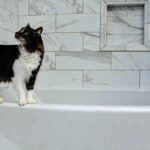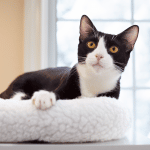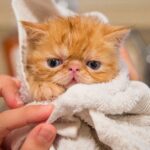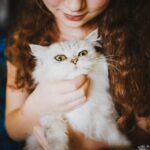Manx cats, a breed that originated from the Isle of Man, are known for their unique characteristics and friendly disposition. These cats stand out among other breeds because of their most distinguishing feature – being entirely tailless or having a small stub of a tail. Along with their tailless appearance, Manx cats also have elongated hind legs and a rounded head, giving them a distinctive look.
This breed’s size is typically compact but incredibly sturdy, with a weight range of 7 to 13 pounds. Manx cats come in a variety of coat colors, including white, blue, black, red, cream, silver, and brown. Their coats can also display different patterns such as bicolor, solid, tortoiseshell, and tabby. The coats can be either short or long hair, and their eye colors can vary from gold, copper, green, hazel, blue, to odd-eyed combinations.
Manx cats are not only recognized for their physical traits but also for their undeniable personality. And take it from this Manx kitty parent – they are loads of fun and can play until they tire YOU out! Known for being easygoing, affectionate, and social, these cats are often described as playful, intelligent, and family-oriented. In fact, some are even known for having puppy or dog-like behavior. With a lifespan of 12 to 16 years, the Manx cat makes a truly fun, devoted, and adorably charming companion!
History of Manx Cats
The Manx cat is a unique and ancient breed with an intriguing history. Originating from the Isle of Man, these cats have been around for centuries, and their distinctive appearance and behavior have made them popular across the world.
One of the earliest linguistic references to tailless cats on the Isle of Man dates back to the mid-18th century, according to Isle of Man resident Sara Goodwins. The Manx cat’s tailless feature is a result of a spontaneous genetic mutation that occurred many centuries ago.
There are numerous legends surrounding Manx cats that help shape this breed’s rich history. One such story connects the Manx to the famed Isle of Man symbol, the Triskelion, a three-legged emblem representing the island’s coat of arms. Local folklore suggests that a Manx cat trampled over the initial design with wet paint on its paws, creating the warped three-legged image seen today. While this tale is endearing, it also reflects the strong connection Manx cats have to the Isle of Man’s cultural identity.
One lesser-known aspect of the Manx cat’s history is its connection to Japan. Manx cats are believed to have been brought to the Japanese archipelago by European traders and sailors during Japan’s period of isolation in the early 17th century. During this time, Japan held a strict ban on Western cultural influences, which included the keeping of foreign pets. However, the unique appearance of the Manx and its adaptability made it an exception, and it gained some popularity among Japanese merchants and nobles.
Manx cats have also been linked to Viking sailors, who may have brought them on their maritime journeys. Their excellent hunting skills and friendly nature possibly made them a valuable addition on Viking ships, and as a result, they might have contributed to the Manx cat’s spread across various regions of Europe and beyond.
Today, the Manx cat continues to be a popular breed known for its affectionate nature and distinct appearance. Though it originated from a small island, its history is an intricate tapestry of mythology, seafaring, and adaptability that spans across generations and cultures.
Physical Characteristics
Body Structure
Manx cats are known for their compact and sturdy size, which typically ranges from 8 to 12 pounds. Their most distinctive feature is their taillessness, resulting from a genetic mutation. This breed has a rounded head and wide-set ears, giving them a unique appearance. Manx cats also have longer hind legs, causing their rump to sit higher than their shoulders. Their elongated legs contribute to their athletic and agile nature.
Coat and Colors
The coat of a Manx cat can be either short or long hair, with both types being recognized in the breed’s standard. They have a dense and plush coat that provides them with good insulation. Manx cats come in a variety of colors, including white, blue, black, red, cream, silver, and brown. Their coat patterns can be solid, bicolor, tortoiseshell, or tabby, among others.
In terms of eye color, Manx cats exhibit diverse shades such as gold, copper, green, hazel, blue, and even odd-eyed combinations. It is essential to note that the coat and eye color of Manx cats are not linked to their tailless mutation.
Manx cats have moderate shedding tendencies, so regular grooming is necessary to maintain a healthy coat and minimize hair buildup in the home. Brushing their coats at least once a week will help to remove loose hair and keep their fur smooth and tangle-free.
Coat Types and Grooming
Manx cats are popular for their unique appearance and gentle personalities. This breed comes in two primary coat types: short-haired and long-haired. Both coat variations have different grooming needs and characteristics, which are crucial to consider when owning a Manx cat.
Short-Haired Manx
Short-haired Manx cats have a dense, plush coat with an underlying double coat. Their fur is soft and silky, requiring minimal grooming to maintain its appearance. It is typically sufficient to brush a short-haired Manx once a week with a gentle brush to remove loose hair and debris, reducing shedding.
To keep a short-haired Manx’s coat healthy and shiny, maintain a consistent grooming routine that includes:
- Weekly brushing with a soft-bristle brush or a rubber brush to remove loose hair.
- Occasional baths with a mild cat shampoo when necessary.
Long-Haired Manx (Cymric)
The Cymric, also known as the long-haired Manx, has a beautiful double coat that is characterized by its lush and plush texture. The coat is longer around the neck, chest, and legs, giving the Cymric a regal appearance.
The grooming needs of a long-haired Manx can be more demanding than that of a short-haired Manx. To maintain the coat of a Cymric cat, it is essential to follow these grooming tips:
- Brush two to three times a week with a slicker brush to remove dead hair and prevent matting.
- Pay attention to areas prone to tangles, such as the chest, armpits, and behind the ears.
- Regularly trim the hair around the hindquarters to prevent fecal matter from sticking to the fur.
- Monthly baths with a mild cat shampoo to keep the coat clean and free of debris.
In conclusion, proper grooming is essential for both short-haired and long-haired Manx cats, with the Cymric requiring a bit more attention. By following these grooming tips, you can ensure your Manx cat’s coat remains healthy, clean, and beautiful.
Tail Variations
Manx cats are known for their distinct tail variations, which are primarily categorized into four types: Rumpy, Rumpy Riser, Stumpy, and Longy. Each type showcases a different tail length and appearance, making it a distinguishing feature for these cats.
Rumpy
The Rumpy Manx cats are completely tailless, exhibiting only a small dimple at the base of the spine where the tail would typically extend. This tail variation is the most iconic characteristic for Manx cats and often makes them stand out compared to other breeds. Rumpies are not only adored for their unique appearance but also possess an easygoing and affectionate personality.
Rumpy Riser
Rumpy Risers have a small stub, consisting of one to three bones, instead of a full tail. This tail variation is slightly longer than the Rumpy type, giving them a stubby appearance. Although they have some tail remnants, the Rumpy Riser Manx cats still maintain the breed’s distinct characteristics such as elongated hind legs, a rounded head, and a variety of coat colors and patterns, including white, blue, black, red, cream, silver, brown, bicolor, solid, tortoiseshell, and tabby.
Stumpy
Stumpy Manx cats have partial tails, which are often curved or kinked, making them appear unique compared to the Rumpy and Rumpy Riser variations. These cats also retain the breed’s other significant traits, such as their elongated hind legs and rounded head. Stumpies are known for their friendly and social demeanor, which often contributes to their popularity among cat lovers.
Longy
A Longy Manx cat has a nearly full-length tail, setting them apart from the other tail variations. Despite having a tail that approaches a typical length for cats, Longy Manx cats continue to possess the breed’s other distinct features, such as elongated hind legs, a rounded head, and various coat colors and patterns. As with the other variations, Longy Manx cats are known for their affectionate and easygoing personalities, making them an excellent choice for pet owners who appreciate the distinct features of the Manx breed while desiring a more traditional tail length.
Personality Traits and Behavior
Manx cats are known for their unique personalities and behaviors. These cats are often described as being playful, intelligent, and affectionate. Their friendly nature makes them suitable companions for families or individuals who enjoy interactive play and socializing with their pets.
Manx cats are quite active and enjoy engaging in various activities such as exploring, playing with toys, and even hunting. They have a natural instinct to be mousers, or hunters of small prey like mice. Although they enjoy being close to their human companions, they also take great pleasure in independently exploring their surroundings and targeting prey-like objects to practice their hunting skills.
These felines are known to be social animals that adore spending time with their human families. They are incredibly affectionate, often forming strong bonds with their owners and seeking out attention from them. However, this attention-seeking behavior is not overly demanding, striking a fair balance between their social nature and the need for some quiet time.
Manx cats are generally friendly with strangers, showcasing their open and curious demeanor. However, they may initially be more cautious and reserved, gradually warming up to unfamiliar faces as they become more acquainted. Their adaptability to new environments and people truly reflects their intelligent nature.
Finally, it is important to note that while Manx cats are not particularly vocal, they still communicate effectively through their body language, such as tail flicks or head nudges. Overall, this breed is characterized by its active, affectionate, and intelligent personality traits, making it a great companion for those who appreciate an engaging and social feline.
Health Issues and Care
Common Health Problems
Manx cats may experience some specific health problems due to their unique physical characteristics. Manx Syndrome is a condition affecting about 16% of Manx kittens, causing several spinal problems, with spina bifida being the most common form. This syndrome can result in symptoms such as spinal deformities, limping, weakness in the hind legs, lack of bladder and bowel control, constipation, seizures, paralysis, and swelling and infection in the spine.
Other potential health issues for Manx cats include arthritis and constipation. Arthritis can result from excess strain on their front legs due to their distinct body shape. Constipation, incontinence, and megacolon are sometimes associated with Manx cats’ unique spinal anatomy.
Diet and Nutrition
A balanced diet is crucial for the health and well-being of Manx cats. Provide them with high-quality cat food containing essential nutrients and vitamins. It is recommended to consult with your veterinarian to determine the best dietary options for your Manx cat. If your cat suffers from constipation, adding fiber to their diet can help alleviate the problem.
Exercise and Play
Manx cats are energetic, social, and playful. Engaging them in regular exercise and play is vital to maintain their physical and mental health. Providing a variety of toys and interactive playtime can help ensure that their front and hind legs remain strong and agile. Climbing structures, scratching posts, and puzzle toys can also stimulate their minds and encourage physical activity. Remember, every cat has its preferences when it comes to play and exercise, so it’s essential to find activities that your Manx cat enjoys.
Remember to regularly consult with your veterinarian to monitor your Manx cat’s health and address any concerns. Providing a loving, safe environment, a proper diet, and regular exercise will contribute to the overall well-being and longevity of your Manx cat.







